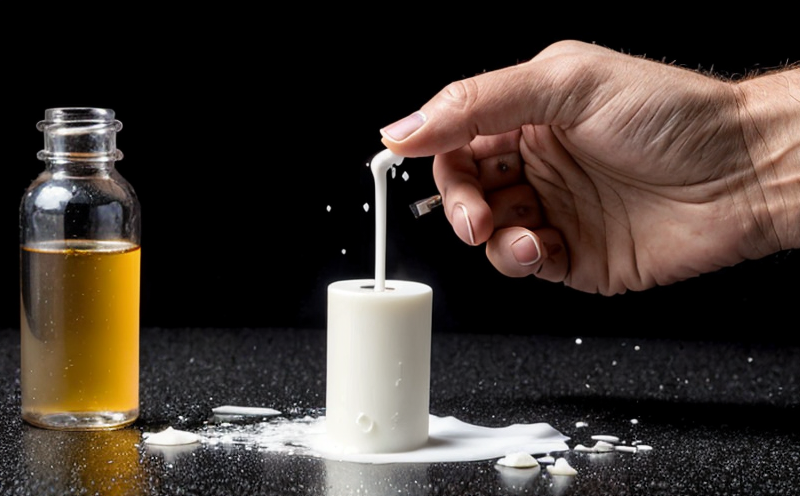USP Dissolution Apparatus 6 Rotating Cylinder Testing
The USP Dissolution Apparatus 6 Rotating Cylinder Test is a critical procedure used to evaluate the dissolution characteristics of solid dosage forms. This test method simulates in-vitro conditions that closely mimic the human gastrointestinal tract, particularly focusing on the disintegration and dissolution processes within the stomach.
The rotating cylinder design allows for a more realistic simulation of the complex motions encountered by tablets or pellets during their passage through the stomach. During this process, the sample is exposed to a fluid environment while undergoing continuous rotation, which enhances the interaction between the drug substance and the solvent. This method provides detailed insights into how effectively the active pharmaceutical ingredients (APIs) are released from various dosage forms.
The test involves several key parameters that must be precisely controlled for accurate results. These include the type of dissolution medium used, the temperature, the speed of rotation, the volume of the apparatus, and the duration of the test. For instance, a higher temperature may indicate faster dissolution rates, while the choice of medium (e.g., buffered hydrochloric acid) mimics physiological conditions.
Preparation of the specimen is also crucial for reliable results. This involves disintegrating the tablet or pellet into granules or smaller pieces if necessary and ensuring they are free from any foreign materials that could interfere with the test. The sample must be accurately weighed to ensure reproducibility, and the amount added should not exceed 10 grams.
The rotating cylinder apparatus itself is a sophisticated piece of equipment designed specifically for this type of dissolution testing. It consists of a cylindrical vessel containing the dissolution medium, which rotates at a controlled speed. The sample is placed in the vessel, and the entire assembly is immersed in a water bath to maintain the specified temperature.
The test duration can vary depending on the specific requirements set by regulatory bodies or clients. However, typical durations range from 15 minutes to several hours, with periodic sampling for analysis. At predetermined intervals, samples are withdrawn and analyzed using appropriate analytical techniques such as high-performance liquid chromatography (HPLC) or UV spectrophotometry.
The results of the USP Dissolution Apparatus 6 Rotating Cylinder Testing are essential for ensuring drug product quality compliance with regulatory standards. Compliance officers rely on these tests to verify that the dissolution profiles meet predetermined specifications, which can impact bioequivalence studies and patient safety. R&D engineers use this data to optimize formulation design by identifying potential issues early in development.
Quality managers depend heavily on accurate and consistent results from such testing to maintain high standards of product quality throughout manufacturing processes. By leveraging robust dissolution data, they ensure that all batches produced meet the stringent requirements set forth by regulatory authorities like the United States Pharmacopeia (USP).
Why It Matters
The importance of USP Dissolution Apparatus 6 Rotating Cylinder Testing cannot be overstated, especially within the pharmaceutical industry. This testing method plays a pivotal role in ensuring product quality and safety by providing detailed insights into how efficiently APIs are released from various dosage forms.
- Ensures Regulatory Compliance: By adhering to USP standards, manufacturers demonstrate their commitment to meeting stringent regulatory requirements. This is particularly important for gaining market access in regions where compliance with these guidelines is mandatory.
- Promotes Consistency: The standardized procedures involved in this testing ensure consistent results across different batches and lots of the same product. This consistency helps maintain brand reputation and customer trust.
- Facilitates Product Development: Early identification of potential issues through thorough dissolution testing allows R&D teams to refine formulations, thereby improving overall efficacy and reducing time-to-market for new products.
Applied Standards
The USP Dissolution Apparatus 6 Rotating Cylinder Testing is governed by specific sections within the United States Pharmacopeia, which provide detailed guidance on methodology and acceptance criteria. Key standards include:
- USP General Chapter Dissolution: Provides comprehensive information on dissolution testing methods including apparatus types.
- USP General Chapter Disintegration: Covers the disintegration process, which is closely related to dissolution for many solid dosage forms.
Competitive Advantage and Market Impact
The ability to perform accurate USP Dissolution Apparatus 6 Rotating Cylinder Testing offers significant competitive advantages in the pharmaceutical market. Here are some key benefits:
- Enhanced Reputation: Companies that excel at compliance with USP standards often enjoy a positive reputation among regulators, healthcare providers, and consumers.
- Increased Market Access: Meeting these stringent testing requirements opens up opportunities for international markets where such compliance is essential.
- Improved Product Quality: Consistent results from rigorous dissolution tests contribute to higher product quality, which can lead to increased customer satisfaction and loyalty.





